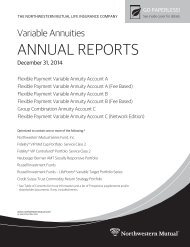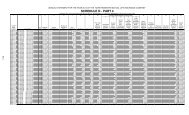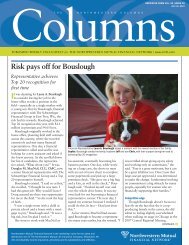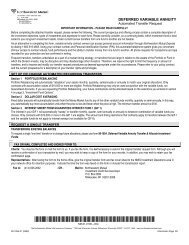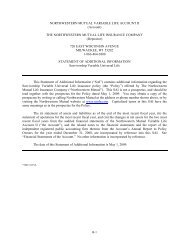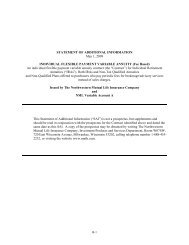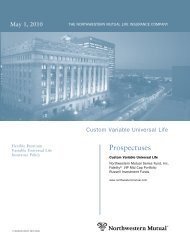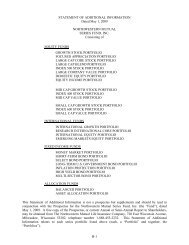following: (i) insufficient trading interest in certain options, (ii) restrictions imposed by a nationalsecurities exchange (“Exchange”) on which the option is traded on opening or closing transactions orboth, (iii) trading halts, suspensions or other restrictions imposed with respect to particular classes orseries of options or underlying securities, (iv) unusual or unforeseen circumstances that interruptnormal operations on an Exchange, (v) the facilities of an Exchange or of the Options ClearingCorporation (“OCC”) may not at all times be adequate to handle current trading volume, or (vi) oneor more Exchanges could, for economic or other reasons, decide or be compelled at some future dateto discontinue the trading of options (or a particular class or series of options), in which event thesecondary market on that Exchange (or in that class or series of options) would cease to exist,although outstanding options on that Exchange that had been issued by the OCC as a result of tradeson that Exchange would continue to be exercisable in accordance with their terms.A Portfolio may write options in connection with buy-and-write transactions. In other words, aPortfolio may buy a security and then write a call option against that security. The exercise price ofsuch call will depend upon the expected price movement of the underlying security. The exerciseprice of a call option may be below (“in-the-money”), equal to (“at-the-money”) or above (“out-ofthe-money”)the current value of the underlying security at the time the option is written. Buy-andwritetransactions using in-the-money call options may be used when it is expected that the price ofthe underlying security will remain flat or decline moderately during the option period. Buy-and-writetransactions using at-the-money call options may be used when it is expected that the price of theunderlying security will remain fixed or advance moderately during the option period. Buy-and-writetransactions using out-of-the-money call options may be used when it is expected that the premiumsreceived from writing the call option plus the appreciation in the market price of the underlyingsecurity up to the exercise price will be greater than the appreciation in the price of the underlyingsecurity alone. If the call options are exercised in such transactions, a Portfolio’s maximum gain willbe the premium received by it for writing the option, adjusted upwards or downwards by thedifference between that Portfolio’s purchase price of the security and the exercise price. If the optionsare not exercised and the price of the underlying security declines, the amount of such decline will beoffset by the amount of premium received.The writing of covered put options is similar in terms of risk and return characteristics to buyand-writetransactions. If the market price of the underlying security rises or otherwise is above theexercise price, the put option will expire worthless and a Portfolio’s gain will be limited to thepremium received. If the market price of the underlying security declines to a price below the exerciseprice, a Portfolio may close the position or the Portfolio may be required to buy the security at theexercise price. In either case, the gain or loss on the transactions will be determined by the premiumreceived when the put option was written minus the amount by which the market price of the securityis below the exercise price.A Portfolio may buy put options to hedge against a decline in the value of its portfolio. By usingput options in this way, a Portfolio will reduce any profit it might otherwise have realized in theunderlying security by the amount of the premium paid for the put option and by transaction costs.A Portfolio may buy call options to hedge against an increase in the price of securities that it maybuy in the future. The premium paid for the call option plus any transaction costs will reduce thebenefit, if any, realized by such Portfolio upon exercise of the option, and, unless the price of theunderlying security rises sufficiently, the option may expire worthless to that Portfolio.The Portfolios may write straddles (combinations of put and call options of the same underlyingsecurity), which are generally a nonhedging technique used for purposes such as seeking to enhancereturn. Because combined options positions involve multiple trades, they result in higher transactioncosts and may be more difficult to open and close out than individual options contracts. The straddlerules of the Code require deferral of certain losses realized on positions of a straddle to the extent thatthe Portfolio has unrealized gains in offsetting positions at year-end. The holding period of thesecurities comprising the straddle will be suspended until the straddle is terminated.B-20
Options on Foreign Currencies. The Portfolios may buy and write options on foreign currenciesin a manner similar to that in which futures or forward contracts on foreign currencies will be utilized.For example, a decline in the U.S. dollar value of a foreign currency in which portfolio securities aredenominated will reduce the U.S. dollar value of such securities, even if their value in the foreigncurrency remains constant. In order to protect against such diminutions in the value of portfoliosecurities, a Portfolio may buy put options on the foreign currency. If the value of the currencydeclines, such Portfolio will have the right to sell such currency for a fixed amount in U.S. dollars,thereby offsetting, in whole or in part, the adverse effect on its portfolio.Conversely, when a rise in the U.S. dollar value of a currency in which securities to be acquiredare denominated is projected, thereby increasing the cost of such securities, a Portfolio may buy calloptions on the foreign currency. The purchase of such options could offset, at least partially, theeffects of the adverse movements in exchange rates. As in the case of other types of options, however,the benefit to a Portfolio from purchases of foreign currency options will be reduced by the amount ofthe premium and related transaction costs. In addition, if currency exchange rates do not move in thedirection or to the extent projected, a Portfolio could sustain losses on transactions in foreign currencyoptions that would require such Portfolio to forego a portion or all of the benefits of advantageouschanges in those rates.The Portfolios may also write options on foreign currencies. For example, to hedge against apotential decline in the U.S. dollar value of foreign currency denominated securities due to adversefluctuations in exchange rates, a Portfolio could, instead of purchasing a put option, write a calloption on the relevant currency. If the expected decline occurs, the option will most likely not beexercised and the decline in value of portfolio securities will be offset by the amount of the premiumreceived.Similarly, instead of purchasing a call option to hedge against a potential increase in the U.S.dollar cost of securities to be acquired, a Portfolio could write a put option on the relevant currencywhich, if rates move in the manner projected, should expire unexercised and allow that Portfolio tohedge the increased cost up to the amount of the premium. As in the case of other types of options,however, the writing of a foreign currency option will constitute only a partial hedge up to the amountof the premium. If exchange rates do not move in the expected direction, the option may be exercisedand a Portfolio would be required to buy or sell the underlying currency at a loss which may not beoffset by the amount of the premium. Through the writing of options on foreign currencies, aPortfolio also may lose all or a portion of the benefits which might otherwise have been obtainedfrom favorable movements in exchange rates.The Portfolios may write covered call options on foreign currencies. A call option written on aforeign currency by a Portfolio is “covered” if that Portfolio owns the foreign currency underlying thecall or has an absolute and immediate right to acquire that foreign currency without additional cashconsideration (or for additional cash consideration held in a segregated account by its custodian) uponconversion or exchange of other foreign currencies held in its portfolio. A call option is also coveredif a Portfolio has a call on the same foreign currency in the same principal amount as the call writtenif the exercise price of the call held (i) is equal to or less than the exercise price of the call written or(ii) is greater than the exercise price of the call written, if the difference is maintained by suchPortfolio in cash or other liquid assets in a segregated account with the Portfolios’ custodian.The Portfolios also may write call options on foreign currencies for cross hedging purposes. Acall option on a foreign currency is for cross hedging purposes if it is designed to provide a hedgeagainst a decline due to an adverse change in the exchange rate in the U.S. dollar value of a securitywhich a Portfolio owns or has the right to acquire and which is denominated in the currencyunderlying the option. Call options on foreign currencies which are entered into for cross hedgingpurposes are not covered. However, in such circumstances, a Portfolio will collateralize the option bysegregating cash or other liquid assets in an amount not less than the value of the underlying foreigncurrency in U.S. dollars marked-to-market daily.B-21
- Page 4: APPENDIX F - Proxy Voting Policies
- Page 9 and 10: stocks that make up that index. Str
- Page 11 and 12: Interest rate swaps do not involve
- Page 13 and 14: the Adviser or Sub-Adviser will not
- Page 17 and 18: Forward Contracts. The Portfolios m
- Page 19: principal amount as the call writte
- Page 23 and 24: securities. The issuers of the unde
- Page 25 and 26: the former pools. However, timely p
- Page 27 and 28: CMO residuals are generally purchas
- Page 29: utilize the underlying assets may r
- Page 32 and 33: include range floaters which are a
- Page 34 and 35: par unless the price of the underly
- Page 36 and 37: to changes in interest rates genera
- Page 38 and 39: corresponding floaters. The underly
- Page 40 and 41: A Portfolio will not enter into suc
- Page 42 and 43: egulations. The presence of an issu
- Page 44 and 45: Portfolio TurnoverPortfolio turnove
- Page 46 and 47: The ability of the Portfolio to ach
- Page 48 and 49: Advisors, LLC, in accordance with t
- Page 50 and 51: OWNERSHIP OF SHARES OF THE FUNDAll
- Page 52 and 53: on the next $50 million, 0.50% on t
- Page 54 and 55: Independent Registered Public Accou
- Page 56 and 57: Name of Portfolio 2008 2007 2006Int
- Page 58 and 59: Broker High Yield Bond BalancedAsse
- Page 60 and 61: and cost of trade execution of Port
- Page 62 and 63: Effective April 30, 2008, the Fund
- Page 64 and 65: TAXES AND DIVIDENDSEach Portfolio i
- Page 66 and 67: APPENDIX A - Credit RatingsDescript
- Page 68 and 69: F2Good credit quality. A satisfacto
- Page 70 and 71:
. Moody’s Commercial Paper (short
- Page 72 and 73:
Plus (+) or minus (-)The ratings fr
- Page 74 and 75:
APPENDIX B - Directors and Officers
- Page 76 and 77:
Name, Address, andYear of BirthDavi
- Page 78 and 79:
APPENDIX C - Ownership of Shares of
- Page 80 and 81:
SMALL CAP VALUE PORTFOLIOGeneral Ac
- Page 82 and 83:
APPENDIX D - Portfolio ManagersOthe
- Page 84 and 85:
PortfolioManager(s)FundRegisteredIn
- Page 86 and 87:
Compensation of Portfolio ManagersM
- Page 88 and 89:
management firms. Performance is pr
- Page 90 and 91:
Portfolio managers are eligible for
- Page 92 and 93:
PortfolioPortfolio Manager(s)Dollar
- Page 94 and 95:
On August 25, 2005, the Court enter
- Page 96 and 97:
MSA’s Equity Trading Department s
- Page 98 and 99:
ERISA ClientsIn the case of client
- Page 100 and 101:
Shareholder Ability to Call Special
- Page 102 and 103:
• Exercise price• Participation
- Page 104 and 105:
Amend Quorum RequirementsVote propo
- Page 106 and 107:
Vote proposals to increase blank ch
- Page 108 and 109:
employees of Investment Manager and
- Page 110 and 111:
will not support the position of a
- Page 112 and 113:
company specifies the voting, divid
- Page 114 and 115:
egarding whether Investment Manager
- Page 116 and 117:
3. The issuer is an entity particip
- Page 118 and 119:
manager(s) are responsible for maki
- Page 120 and 121:
Global Corporate Governance: Invest
- Page 122 and 123:
13. The Proxy Group will review the
- Page 124 and 125:
determined by those investment comm
- Page 126 and 127:
T. Rowe Price has adopted these Pro
- Page 128 and 129:
shareholders and the effect on shar
- Page 130 and 131:
portfolio company could have influe
- Page 132 and 133:
The Proxy Voting Service will refer
- Page 134 and 135:
that substantially differs from dom
- Page 136 and 137:
15. Janus will generally vote in fa
- Page 138 and 139:
46. For shareholder proposals outsi
- Page 140 and 141:
2. Staggered BoardIf a company has
- Page 142 and 143:
proposed for a legitimate business
- Page 144 and 145:
APPENDIX G - Portfolio Holdings Dis
- Page 146:
ICP Securities LLCIntermonte Securi



